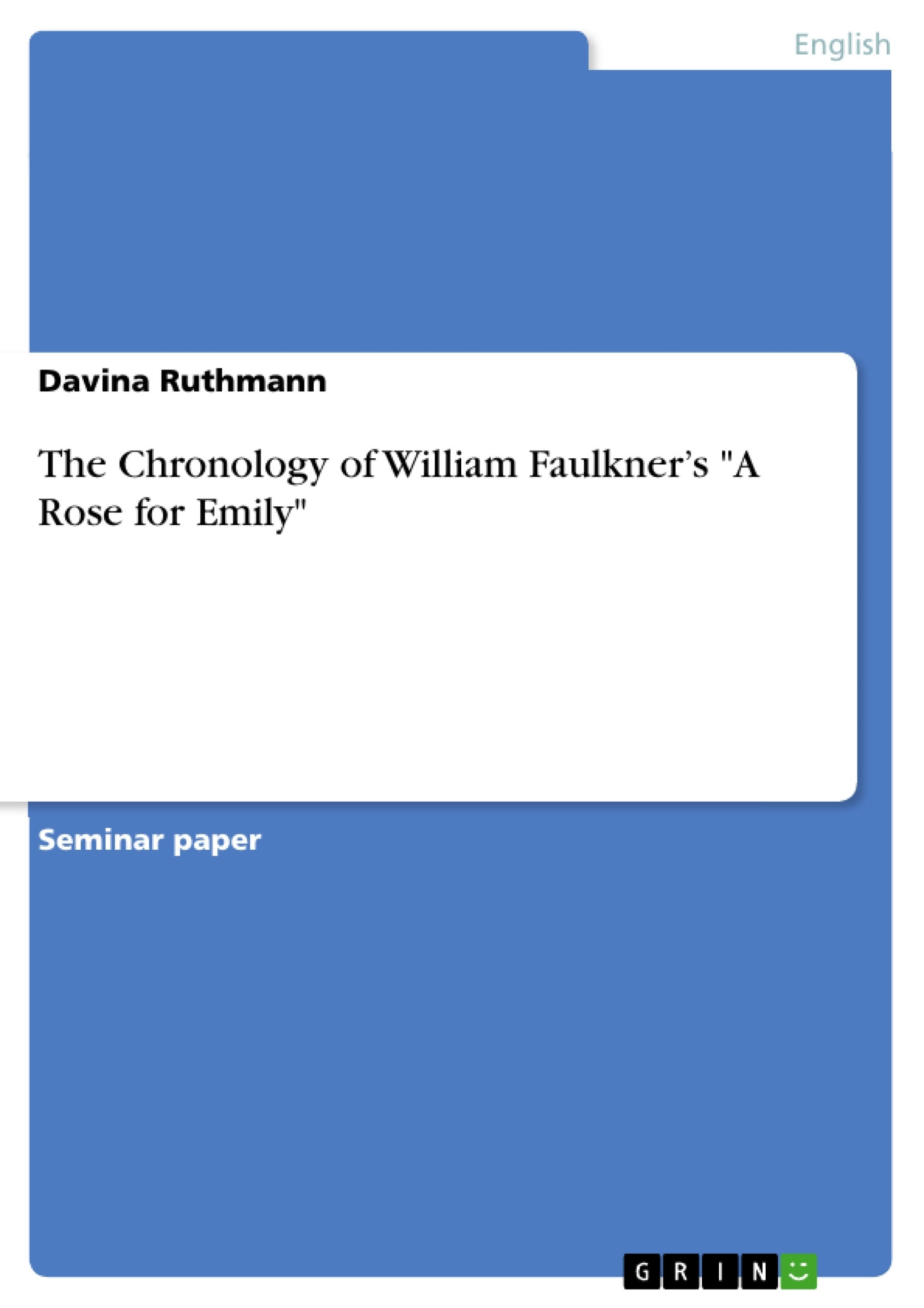”At the heart of the modernist aesthetic lay the conviction that the previously sustaining structures of human life, whether social, political, religious, or artistic, had been either destroyed or shown up as falsehoods or fantasies” (Norton 1814). Thus literary features such as sequence or unity turned out to be only “expressions of a desire for coherence”. This “false order” had to be renovated to express the new interpretation of the world as a broken image. As a consequence, modernist literature abandons former traditional ideals. Instead of the tyranny of chronology, it is the construction out of fragments that now becomes a key formal characteristic. Without showing any linear sequence of events, Faulkner’s narrative technique in ”A Rose for Emily” mirrors exactly this modernistic ideal. By avoiding the chronological order of events, Faulkner gives the reader a puzzle consisting of fragments. Nevertheless, he gives hints that make it possible to put these fragments together and thus reconstruct the chronology of the life of Miss Emily Grierson. In order to find out “what dates are carved on [her] tombstone” (Moore 196) the reader has to become active which is a common attribute in modernist texts. “A chronology of ‘A Rose for Emily’”, as stated by McGlynn, “is useful for at least two reasons: it makes the plot more easily comprehensible, and it helps clarify the function of time in the story” (461).
Table of Contents
- Introduction
- Problems of Chronology
- Part I
- Part II
- Part III
- Part IV
- Part V
- Appendix
- Bibliography
Objectives and Key Themes
This essay analyzes the chronology of William Faulkner's short story "A Rose for Emily," exploring how the narrative structure, fragmented timeline, and the reader's active role in piecing together events contribute to the story's modernist aesthetic.
- Modernist literary techniques in "A Rose for Emily"
- The importance of chronology in understanding the story
- The role of the narrator and the reader in constructing the chronology
- The significance of internal and external evidence in dating events
- The portrayal of Miss Emily Grierson's life and relationships
Chapter Summaries
The essay begins by establishing the context of modernist literature and its departure from traditional chronological narratives. It highlights how Faulkner's narrative technique in "A Rose for Emily" mirrors this modernist ideal by presenting a fragmented and nonlinear chronology.
The second part delves into the challenges of constructing a chronology from the fragmented narrative, focusing on the ambiguous nature of the narrator's perspective and the need for the reader to actively interpret the clues presented. It explores the story's structure, which consists of five parts, with the first and last focusing on Miss Emily's death and the intervening sections presenting flashbacks to different periods in her life. The essay emphasizes how the flow of memories and the lack of a clear timeline force the reader to piece together a coherent chronology.
The third part examines the first part of the story, analyzing the various clues about Miss Emily's life, such as her isolated lifestyle, the references to the post-Civil War era, and the tax exemption granted to her in 1894. The essay discusses the limitations of using the tax exemption as a starting point for constructing a chronology, as it does not definitively establish the date of Emily's father's death. The essay also introduces the contrasting views of different chronologists, particularly those of McGlynn and Moore, on the interpretation of the temporal relationships between events.
The fourth part analyzes the second part of the story, further exploring the fragmented nature of the narrative and the reader's task of piecing together the timeline. It emphasizes the importance of seemingly incidental details, such as the age of Judge Stevens, in challenging the assumptions of other chronologists. The essay suggests that Emily's father's death occurred significantly earlier than the date of her tax exemption.
The fifth part focuses on the third part of the story, examining Emily's illness, the arrival of Homer Barron, and her purchase of arsenic. The essay uses the clues in this section to establish Emily's age and the timeframe surrounding the events.
Keywords
This preview focuses on the chronology of "A Rose for Emily" by William Faulkner, using concepts such as fragmented narrative, modernist aesthetic, internal evidence, external evidence, stream of consciousness, and the reader's active role in constructing meaning.
- Quote paper
- Davina Ruthmann (Author), 2005, The Chronology of William Faulkner’s "A Rose for Emily", Munich, GRIN Verlag, https://www.grin.com/document/74284



